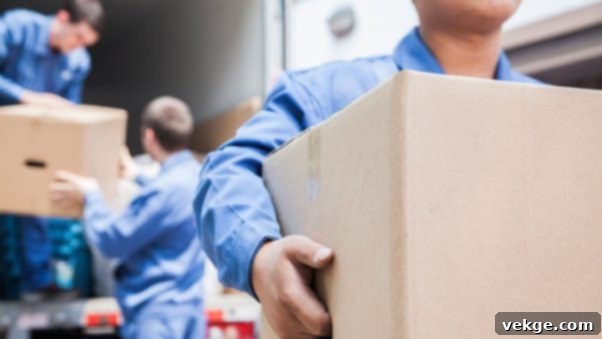Ultimate Guide to Stress-Free Local Moving: Tips, Costs, and Hiring Expert Movers
Moving locally, whether it’s just across the street or to a neighboring town, often appears simpler than a long-distance relocation. However, this perception can be misleading. A successful local move demands just as much meticulous planning, organization, and attention to detail to ensure a smooth transition. From the initial stages of decluttering your belongings to the final moments of settling into your new residence, every step requires careful consideration.
The journey involves a myriad of tasks, including meticulously packing each item, arranging for safe transport, and setting up your new home environment. Amidst these responsibilities, engaging local movers can be a pivotal decision. Professional assistance offers invaluable expertise, ensuring your possessions are transported securely and efficiently, thereby mitigating many common moving-day stresses.
This kind of professional help is not just about physical labor; it’s about navigating the complex logistical challenges that accompany relocating your entire life. Experts understand the nuances of local moves, from navigating specific city regulations to efficiently packing fragile items, making the entire process significantly less daunting.
For many, the allure of moving locally stems from the promise of a fresh start without the overwhelming cultural and environmental changes associated with a long-distance move. It’s about the joy of establishing a new home while remaining deeply connected to familiar surroundings, amenities, and community. This unique blend of novelty and comfort makes local relocation an appealing choice for individuals and families seeking change without venturing too far from their established comfort zones.
With the right preparation and a reliable team of local movers, a short-distance move transforms from a potential headache into a rewarding and energizing experience. It opens doors to new possibilities within a cherished community, allowing you to embrace new beginnings while keeping one foot firmly planted in familiar territory. This comprehensive guide will walk you through every aspect of ensuring your local move is as seamless and stress-free as possible.
Planning and Preparation for Your Local Move
Effective planning is the cornerstone of any successful move, regardless of distance. For local moves, starting early and maintaining a structured approach can save you time, money, and considerable stress.
Start Early: The Foundation of a Smooth Local Relocation

It is highly recommended to initiate the planning phase for your local move at least six to eight weeks before your anticipated moving date. This generous timeframe provides ample room to maneuver through every aspect of the relocation process without feeling rushed or overwhelmed. Early planning allows you to systematically address tasks such as decluttering, sourcing packing materials, coordinating with local movers, and finalizing logistics for moving day.
Commencing early significantly minimizes potential hitches and last-minute panic. For instance, booking reputable movers well in advance, especially during peak moving seasons, ensures you secure your preferred date and a reliable team. It also allows time to compare quotes and services without pressure. Moreover, an early start gives you the flexibility to handle unexpected issues, such as delayed delivery of packing supplies, scheduling conflicts with service providers, or unforeseen alterations to your new home, without derailing your entire move.
This proactive approach ensures a more paced and controlled process, reducing stress and allowing you to enjoy the excitement of a new beginning rather than battling logistical nightmares.
Create a Comprehensive Moving Checklist
A detailed moving checklist is your indispensable guidebook throughout the entire transition period. It transforms an overwhelming project into a series of manageable, actionable steps. Begin by categorizing tasks by their urgency and deadlines, assigning them to different phases of your move.
- 8-6 Weeks Out: Start by researching and identifying reputable local movers, obtaining multiple quotes, and booking your preferred company. Begin the decluttering process, sorting through belongings to decide what to keep, donate, sell, or discard. Research and purchase necessary packing supplies like boxes, tape, bubble wrap, and markers. Notify landlords (if renting) and start gathering important documents.
- 4-3 Weeks Out: Begin packing non-essential items, starting with seldom-used rooms or seasonal items. Arrange for utility transfers (electricity, water, gas, internet) at both your current and new homes. Update your address with the post office, banks, insurance providers, and subscriptions. Inform schools, doctors, and other service providers of your upcoming move.
- 2-1 Week Out: Finish packing all but the absolute essentials. Confirm moving day details with your movers. Arrange for professional cleaning services for your old home if needed. Pack an “essentials” box or bag for moving day and your first night in the new home. Defrost and clean your refrigerator. Confirm pet care or childcare arrangements for moving day.
- Moving Day: Oversee the movers, ensuring all boxes are loaded. Do a final walkthrough of your old home to ensure nothing is left behind. Sign off on all moving documents. Meet movers at your new home and direct them on where to place boxes.
This checklist serves as a visual progress tracker, ensuring no crucial steps are overlooked. It not only breaks down the move into digestible activities but also reminds you of approaching deadlines, such as canceling local service providers and establishing new ones, thereby preventing last-minute crises. A well-structured checklist empowers you to stay organized and in control, making your local move remarkably smoother.
Hiring Professional Local Moving Help
While a local move might tempt some to DIY, professional movers offer expertise, efficiency, and peace of mind that can be invaluable. Here’s how to ensure you hire the best help for your relocation.
Researching and Selecting Local Moving Companies

When seeking a local moving company, thorough research is paramount. Begin by checking online reviews and ratings on reputable platforms such as Yelp, Google Reviews, and the Better Business Bureau (BBB). Look for consistently positive feedback regarding punctuality, professionalism, care for belongings, and customer service. High ratings and glowing testimonials are strong indicators of reliability and customer satisfaction.
Beyond online sources, solicit recommendations from friends, family, or colleagues who have recently moved locally. Personal referrals often lead to trusted service providers. Once you have a shortlist, contact multiple companies to request detailed quotes and compare their services. Ensure they provide a written estimate, clearly outlining all costs and services included.
Crucially, verify that any potential movers are fully licensed and insured. Licensing ensures they meet industry standards and regulations, while insurance protects you financially in the event of damage or loss to your belongings during transit. You can typically verify a mover’s license number through your state’s Department of Transportation or an equivalent regulatory body. Never hire a mover who cannot provide proof of valid licensing and comprehensive insurance coverage.
Understand the types of insurance coverage different movers offer. Basic valuation coverage, often included, may only cover a fraction of your items’ actual value based on weight, not monetary worth. For valuable or fragile items, consider purchasing additional “full value” protection directly from the moving company or through a third-party insurance provider. Discuss these options thoroughly to ensure your prized possessions are adequately protected.
Essential Tips for a Seamless Local Moving Experience

Strategic Planning Ahead
Initiating your moving preparations at least a month in advance is crucial for a truly stress-free local relocation. This forward-thinking approach provides several significant advantages. Firstly, it allows you to secure the best local movers, whose schedules, especially during peak moving seasons (late spring to early fall, and month-ends), can fill up rapidly. Early booking ensures you get your preferred date and a reputable team. Secondly, this foresight grants you ample time to address any unforeseen challenges, changes, or adjustments without succumbing to panic. Whether it’s a minor delay in utility setup or a sudden need for specialized packing materials, you’ll have the bandwidth to resolve issues calmly, ensuring everything flows smoothly on the big day. Planning ahead also includes researching parking restrictions at both locations and reserving elevator times if applicable, preventing last-minute logistical headaches.
Decluttering: Minimizing Your Moving Load
Decluttering is perhaps one of the most impactful steps you can take before you even begin packing. It’s an exceptionally effective way to reduce the overall volume and weight of items you need to move, which can significantly lower your moving costs if you’re paying by weight or cubic foot. Take this invaluable time to critically assess every item you own: do you need it? Is it still useful or brings you joy? Consider the “one-year rule” – if you haven’t used an item in the past year, it’s likely a candidate for removal.
There are several avenues for decluttering: selling valuable items through online marketplaces or consignment can add to your moving budget; donating gently used goods to local charities provides a sense of contribution and helps those in need; and properly disposing of unwanted items (including hazardous waste like old paints or chemicals, which movers won’t transport) means fewer boxes and less to unpack. A thorough declutter not only saves money but also leads to quicker packing, unpacking, and a more organized new home.
Gathering Essential Moving Supplies
Cost-Effective and Secure Packing
While collecting free boxes from local grocery stores, liquor stores, or online community groups can be a great way to save money, it’s equally important to invest wisely in high-quality packing materials for your most fragile and valuable items. Relying solely on flimsy, worn-out boxes can lead to damage during transit, costing more in replacements than you saved. Purchase sturdy, new moving boxes in various sizes, especially for heavier items like books (small boxes) and lighter, bulkier items like linens (large boxes).
Essential investments include bubble wrap for delicate items, packing paper or newsprint (unprinted is best to avoid ink transfer) for cushioning, strong packing tape, and markers. Specialty boxes, such as wardrobe boxes for hanging clothes, dish packs for kitchenware, and mirror/picture boxes, are worthwhile for ensuring specific items arrive in pristine condition. Don’t forget utility items like box cutters, scissors, and furniture blankets or moving pads.
Labeling Thoroughly for Efficient Unpacking
Streamlining Your Arrival
Clearly labeling each box with its contents and the room it’s destined for is a simple yet profoundly impactful step that not only organizes the moving process but dramatically streamlines the unpacking phase. This straightforward practice can save you and your family hours of searching for items and ensures that boxes end up in the correct rooms, ready to be unpacked with ease. Imagine finding your coffee maker on the first morning without rummaging through dozens of boxes!
Consider implementing a detailed labeling system:
- Room Name: Clearly write the destination room (e.g., “Kitchen,” “Master Bedroom,” “Living Room”).
- Contents Summary: List key items (e.g., “Pots & Pans,” “Books – Fiction,” “Linens & Towels”).
- Fragile Warning: Mark “FRAGILE” on boxes containing delicate items, perhaps with an arrow indicating “This End Up.”
- Numbering System: Assign a number to each box and create a master inventory list that details the contents of each numbered box. This is particularly useful for insurance purposes or tracking.
- Color-Coding: Use different colored labels or markers for each room. This visual cue is incredibly helpful for movers who will need quick direction on where to place items, speeding up the unloading process.
This level of organization makes settling into your new home far less stressful and much more efficient.
Keeping Essentials Accessible
Immediate Needs on Moving Day
Packing an “essentials bag” or “first-night box” is crucial for your first day and night in the new home. This ensures you won’t have to rummage through countless boxes for basic necessities. This bag should be packed last and kept with you during the move, not on the moving truck. It should include:
- Toiletries: Toothbrushes, toothpaste, soap, shampoo, toilet paper, hand sanitizer.
- Medications: All prescription and over-the-counter medications you regularly use.
- Change of Clothes: A few comfortable outfits for each family member.
- Important Documents: IDs, passports, birth certificates, moving contracts, insurance papers, school records, pet vaccination records, and any financial documents.
- Chargers: For phones, laptops, and other essential electronics.
- Snacks & Drinks: Easy-to-eat snacks, water bottles, and perhaps instant coffee or tea.
- Basic Tools: A small toolkit (screwdriver, wrench, pliers) for quick assembly needs.
- Pet Supplies: Food, water bowl, leash, toys, litter box.
- Kid Essentials: Favorite toys, comfort items, diapers, wipes.
- Cleaning Supplies: A roll of paper towels, all-purpose cleaner, a sponge, small trash bags.
Having these items readily available will make the first 24-48 hours in your new environment significantly more comfortable and less chaotic.
Understanding the Cost of Moving Furniture Locally
Variable Expenses for Furniture Transport
The cost to move furniture locally is influenced by several key factors. These include the total amount and weight of furniture, the exact distance of the move (even within a local radius), and any special handling requirements. Items such as grand pianos, delicate antiques, large appliances, or complex electronics often require specialized equipment, extra movers, or specific packing techniques, which can incur additional charges.
Typically, for professional local furniture moving services, you can expect to pay an hourly rate. This rate often ranges between $75 and $250 per hour, covering the services of a professional moving team, the use of a moving truck of appropriate size, and all necessary tools and equipment for safe transport (e.g., dollies, straps, furniture pads, dis/assembly tools). Factors like the number of flights of stairs, difficult access points, or narrow hallways at either location can also impact the time required and, consequently, the final cost.
How Much Do Local Movers Cost? A Detailed Breakdown

Understanding the pricing structure of local movers is essential for budgeting your relocation. Most local moving companies offer a few different pricing models, primarily hourly rates or flat rates, along with potential additional costs.
Hourly Rates: The Most Common Local Moving Cost
The vast majority of local movers charge an hourly rate, which typically ranges between $30 and $50 per mover. This rate is usually comprehensive, encompassing the use of the moving truck, the labor involved in efficiently loading and unloading your belongings, and the standard moving equipment necessary to secure and transport your items safely (e.g., dollies, furniture pads, hand trucks). The total hourly cost will depend on the number of movers assigned to your job (e.g., two movers at $40/hour would be $80/hour). Factors like the size of your home, the amount of items, and the complexity of the move (stairs, long carrying distances) will dictate the total hours required.
It’s crucial to clarify with the moving company precisely what is included in this hourly rate. Some companies might charge additional fees for fuel, mileage (though less common for truly local moves), or specific types of equipment, so always ask for a detailed breakdown to avoid hidden surprises.
Flat Rates: Predictability for Well-Defined Moves
For simpler, highly standardized, or very well-defined local moves, some moving companies may offer flat rates. This pricing model can be particularly advantageous for individuals who have accurately assessed their moving needs and can provide detailed information about the quantity and type of furniture and belongings being moved, as well as clear access conditions at both the origin and destination locations. Flat rates are often offered after an in-home estimate where a representative assesses the scope of work.
The primary benefit of a flat rate is its predictability; it ensures that the cost of the move is fixed and known upfront, with no surprises, assuming that the move conditions do not change significantly from what was initially expected. This can be ideal for budget planning and peace of mind.
Additional Costs: Accounting for Specialized Services
When planning your move, it’s vital to consider potential additional services you might need, as these can increase the overall cost. These services are typically not included in the standard hourly or flat rate and might be charged separately:
- Professional Packing and Unpacking: If you opt for movers to pack or unpack your boxes, expect an additional hourly or per-box fee.
- Disassembly and Reassembly of Furniture: While basic furniture disassembly (like beds) might be included, complex items or extensive furniture work could incur extra charges.
- Specialty Item Transport: Moving unusually heavy, fragile, or oversized items (pianos, hot tubs, art pieces, safes) often requires specialized equipment, additional manpower, and expertise, leading to extra fees.
- Stairs or Long Carries: If movers need to navigate multiple flights of stairs or carry items a significant distance from the truck to your door, a “long carry” or “stair carry” fee may apply.
- Temporary Storage: If there’s a gap between your move-out and move-in dates, temporary storage services offered by the moving company will add to your expenses.
- Moving Supplies: Boxes, bubble wrap, packing tape, and other materials provided by the movers will be an added cost.
- Shuttle Service: If the moving truck cannot access your home directly (e.g., due to narrow streets or regulations), a smaller shuttle truck might be used, incurring an extra charge.
Always discuss these potential costs upfront with your moving company to receive a transparent quote and manage your budget more effectively, avoiding unexpected expenses on moving day.
How Much to Tip Local Movers: A Guide to Showing Appreciation

Tipping movers is a common practice, though not strictly mandatory. It’s a way to acknowledge and appreciate the hard work, physical exertion, and professionalism involved in safely transporting your belongings. Here are some guidelines to help you decide how much to tip:
Standard Tipping for Good Service
A widely accepted guideline for tipping movers who provide good, reliable service is $4 to $5 per hour per mover. This amount is considered a courteous recognition of their effort and dedication to safely and efficiently handling your possessions. For example, if two movers work for 4 hours, a tip of $32-$40 would be appropriate ($4-5/hour x 2 movers x 4 hours). If the movers spend several hours at your home, carefully packing, loading, and unloading, this can accumulate into a significant token of appreciation by the end of the day.
Tipping for Exceptional Service and Challenging Conditions
If your movers go above and beyond, providing exceptional service, navigating particularly challenging conditions, or demonstrating extraordinary care, a higher tip is certainly warranted and appreciated. Consider increasing the tip to $6 to $8 per hour per mover. Examples of exceptional circumstances include:
- Cumbersome Furniture: Expertly handling extremely heavy or awkward pieces that require significant effort.
- Numerous Stairs: Repeatedly carrying items up or down multiple flights of stairs at either location.
- Long Carries: Having to transport items a long distance from the truck to the entrance due to access limitations.
- Extremely Delicate Items: Showing meticulous care and specialized handling for fragile, valuable, or sentimental items.
- Unforeseen Challenges: Adapting positively to unexpected problems or last-minute changes.
- Exceptional Efficiency: Completing the move much faster than anticipated while still maintaining high quality.
A higher tip in these situations genuinely reflects your gratitude for their extra effort and professional handling of difficult tasks.
General Guideline: A Flat Rate Approach
If calculating hourly tips seems too complex or time-consuming, a simple flat tip per mover for the entire day’s work is also an acceptable and common way to show your appreciation. A range of $20 to $40 per mover for a full day’s job is a good starting point. This method is straightforward and ensures each member of the moving team is rewarded for their service, making it clear that you value and recognize their hard work without needing to track every minute. Ultimately, the amount you tip should reflect your satisfaction with the service received and your budget.
Conclusion: Your Path to a Seamless Local Move
Moving locally, while often perceived as less complicated than a cross-country relocation, requires diligent planning and meticulous execution to be truly stress-free. By adhering to the detailed steps outlined in this guide – from starting your preparations early and creating a comprehensive checklist, to carefully researching and hiring professional local movers, and implementing smart packing and labeling strategies – you are well-equipped for a successful and smooth transition.
Remember that effective decluttering can significantly reduce your workload and costs, while a well-stocked essentials bag will provide immediate comfort in your new home. Understanding the cost structures for local movers and knowing how to appropriately tip for their hard work ensures a transparent and appreciative experience.
Embrace flexibility and thorough preparation as your key allies in overcoming any challenges that may arise during the move. With these insights and strategies, you’re not just moving boxes; you’re orchestrating a positive new beginning. May your local move be rewarding, energizing, and lead you quickly to settling into and enjoying your new surroundings. Happy moving!
